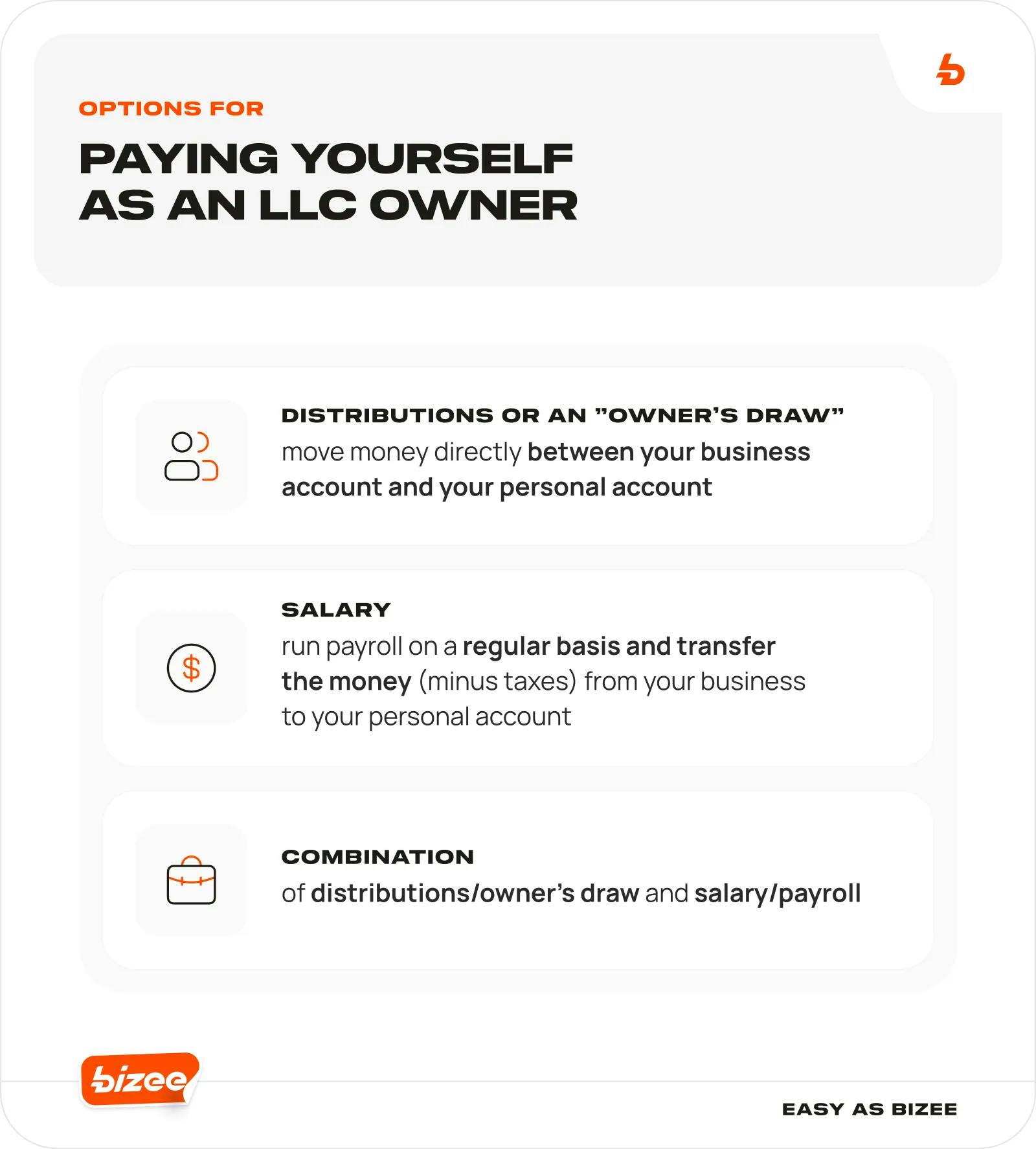Please note: This post contains affiliate links and we may receive a commission if you make a purchase using these links.
TABLE OF CONTENTS
Starting your business is an exciting time, and one vital part of that is knowing how you're going to pay yourself. Once the money's coming in, just how do you get it out of your LLC? Depending on the type of LLC you run, you have a few different options.
We'll cover the various ways you can take money out of your business and the implications of doing so below.
Using Your Business Bank Account to Pay Yourself
Paying yourself as an LLC owner means moving money from the LLC business bank account to your personal account.
You’ll use your business bank account to take in revenue, hold money and pay expenses. When you pay yourself as an LLC owner, you move money from your business bank account into your personal one.
You have a few ways to move this money, and this will be determined by the type of LLC that you’re running.
If You’re a Single-Member LLC Taxed as a Sole Proprietorship
Single-member LLCs taxed as sole proprietorships can simply log into the banking portal for the LLC business account and move money to the owner’s personal account. You would then show the amount that you’ve transferred over as a “drawing” or “owner draw” in your bookkeeping software.
If You’re a Multi-Member LLC Taxed as a Partnership
Multi-member LLCs taxed as partnerships can simply log into the banking portal for the LLC business account and move money to each of the owner’s personal accounts.
You would transfer money between accounts based on the profit-sharing rules or guidelines within your operating agreement. For example, if you have four partners, each owning a quarter of the business, you would transfer 25 percent of the profits that you’re taking out of the business to each partner.
You then show the amount that you’ve transferred over to each owner as a “drawing” or “owner draw” in your bookkeeping software.
If You’re a Single- or Multi-Member LLC Taxed as an S Corporation
LLCs can file Form 2553 with the IRS to be treated as an S Corporation for tax purposes. This often allows LLCs to pay lower self-employment taxes, increasing tax savings overall. One requirement to using this tax classification is that any owners must be treated as employees and paid through a payroll service. There are many payroll providers available, and the features they offer will vary between providers.
If you do run payroll, which must be the case if you file taxes as an S Corporation, then the payroll service may have built-in functionality to move money between your business and personal accounts as part of the employee salary payment process. In other cases, you may need to move money manually. Check the documentation and features of your payroll service to understand how this works.
It’s also important to note that owners of an LLC taxed as an S Corp can move some money from the business bank account to their personal bank accounts outside a payroll service — more on that below. In those cases, you can use the same approach as we’ve described above for single- or multi-member LLCs.
Of course, no matter how you pay yourself, the IRS is also going to want their cut!
Paying Taxes on LLC Profits
One important area to understand as an LLC owner is the taxes you'll owe. Generally, you will pay taxes on your profits, whether you use them to pay yourself, keep them in the business or do something else with them.
You don’t need to take money out of your LLC to incur or pay taxes. So, if your LLC has revenue of $150,000 and expenses of $50,000, you pay taxes on the $100,000 profit. It doesn’t matter if you transfer $0, $50,000 or $100,000 of that as pay between your business and personal bank account — you’ll still pay taxes on the whole amount.
If you pay yourself through a payroll system, there is an exception to this, as there are a couple of taxes (FUTA and SUTA) that you only pay on the salaried amount you pay yourself. But, if you’re not using a payroll system and paying yourself through distributions, that tax is the same whether the money is in your personal account or your business one.
Further Information on How to Pay Yourself as an LLC Business Owner
Building on what we’ve discussed previously, let’s dig into owner’s draws and salary/payroll a little further. LLC business owners have three options for paying themselves:
- Distributions or an “Owner’s Draw,” where you move money directly between your business account and your personal account
- Salary, where you run the payroll on a regular basis and you or the payroll system transfers the money, fewer taxes, between your business and personal account
- A combination of distributions/owner’s draw and salary/payroll

Here's when to use each of these.
When to Pay Yourself Using a Distribution or Owner’s Draw
You will normally use a distribution or owner’s draw to pay yourself if:
- You are a single-member LLC taxed as a sole proprietor, and you file a Form 1040 together with a Schedule C and a Schedule SE to report your taxes each year.
- You are a multi-member LLC taxed as a partnership, and you file a Form 1040 together with a Schedule K and a Form 1065 to report your taxes each year.
You do not need to use a formal payroll system, as any business profits will “pass-through” to your personal tax return, where you’ll calculate and pay taxes.
In both cases, you can just use an owner’s draw to pay yourself. You do this by simply transferring the money from your business account to your personal account and showing the transaction in your bookkeeping system as a distribution or owner's draw.
When you pay yourself using a distribution, there are no taxes withheld from the payment amount. This means you will need to calculate and pay estimated taxes on your business profits on a quarterly basis. You will typically owe and need to pay estimated amounts for self-employment tax, federal income tax and state income tax.
When to Pay Yourself Using a Salary and Payroll System
Most LLC owners will only use a salary and payroll system to pay themselves if:
- You are a single- or multi-member LLC that has chosen to be taxed as an S Corporation, and you file a Form 1120-S together with your Form 1040 to report your taxes each year. You will also file a W2 and other payroll tax forms.
If you’re an LLC that’s chosen to be taxed as an S Corporation, you must pay yourself a “reasonable salary” through your payroll system.
Before you can do this, you will need to set up a payroll service using software like Gusto, Paychex, ADP or Patriot. Alternatively, your accountant may be able to set up and run payroll on your behalf.
Once you have a payroll system, you will run payroll on a regular basis and transfer the money as directed. You will show all of your payroll transactions in your bookkeeping system.
When you pay yourself through a payroll system, that system will calculate any self-employment, federal income, state income, FUTA and SUTA taxes that you might need to pay. Full-service payroll systems will also file the relevant tax forms, withdraw the taxes and pay them on your behalf.
Keep in mind that owners of LLCs taxed as C Corporations will also use payroll systems to pay themselves, but tax management and implications for C Corps are involved and complex. In these cases, we recommend speaking to your accountant.
When to Combine an Owner Draw and Payroll to Pay Yourself
Some LLC owners may choose to combine paying themselves through payroll and with an owner draw. This will normally be because you’ve chosen to be taxed as an S Corporation. In these cases, you won’t pay self-employment tax on the distribution amount, which will provide a tax saving.
If you go down this route, you will still need to calculate and pay quarterly estimated federal and state income taxes on any money you took out through the distribution method.

Frequently Asked Questions on Paying Yourself as an LLC Owner
Still have more questions? Here's a quick look at some common areas.
How Do I Pay Myself as a Single-Member LLC Owner?
If you’re taxed as a sole proprietor, use a distribution to pay yourself. If you’re taxed as an S Corp, use a payroll system with an option to also pay part of your salary through a distribution.
How Do I Pay Myself as a Multi-Member LLC Owner?
If you’re taxed as a partnership, use a distribution to pay yourself and your partners based on the ownership percentage set out in your operating agreement. If you’re taxed as an S Corp, use a payroll system with an option to also pay part of your salary through a distribution.
Why Is My Operating Agreement Important for Paying Owners as Part of a Multi-Member LLC?
An operating agreement is a formal document that’s used to clarify how your LLC is managed and run. Ideally, you’ll create an operating agreement when you first set up your LLC and get all of your owners (managers or members) to sign the agreement, so everyone is agreeing to a commonly agreed set of standards.
You may then amend the operating agreement as required.
One important aspect of your operating agreement is that it will set out the profit-sharing rules for your LLC — specifically, how much of your profits are distributed to each owner based on their ownership percentage. Whenever you are paying an LLC owner, ensure that you meet the requirements of your profit-sharing agreement.
How Do I Pay Myself as a Series LLC Owner?
Owning a Series LLC does not change the way you pay yourself. Use the guidance based on whether you’re a single- or multi-member LLC or you’re taxed as an S Corp.
Can Members of an LLC Take a Salary?
You only need to “take a salary” if you’re paying yourself through a payroll system. You would normally do that if you’re being taxed as an S Corp. If you’re taxed as a sole proprietor (single-member LLC) or a partnership (multi-member LLC), then you don’t normally need to take a salary. Instead, you would take a distribution or owner’s draw.
Can LLC Owners Pay Themselves Through Payroll?
You would typically only pay yourself through payroll if you’re being taxed as an S Corp. If you’re taxed as a sole proprietor (single-member LLC) or a partnership (multi-member LLC), then you don’t normally need to pay yourself through a payroll system. Instead, you would take a distribution or owner’s draw.
How Much Should an S Corporation Owner’s Salary Be?
The IRS does not provide detailed guidelines on how much you should pay yourself via a salary if you’re taxed as an S Corporation. This is what the IRS says: “S corporations must pay reasonable compensation to a shareholder-employee in return for services that the employee provides to the corporation before non-wage distributions may be made to the shareholder-employee.”
In practice, this means you need to pay yourself at least as much as you would pay someone else to do an equivalent job to yours if you were employing them. For example, if you’re a freelance designer running an LLC full-time and you needed to hire a designer to work for you, then you’d research what a designer’s salary is likely to be. In this case, you might look at a website like Glassdoor and see that a designer’s salary is $45,000 a year. That means you should set your own salary to at least match that amount.
It’s also important to point out that if you’re taxed as an S Corporation, your health insurance premiums and 401(K) retirement plan contributions are also counted towards your total compensation as an officer.
Financial Management for Your LLC
Remember that you’ll also need to practice good financial management for your LLC. Pay attention to seasonal trends and their impact on your revenue and profits. Keep enough money in your business to meet all of your commitments, and carefully consider how much you pay yourself versus your upcoming expenses.
If you need help with your bookkeeping and taxes, Bizee can help. We provide a complete Accounting and Bookkeeping service to stay on top of your finances and remove the stress and hassle of paying your taxes.

Paul Maplesden
Paul is a freelance writer, small business owner, and British expat exploring the U.S. When he’s not politely apologizing, he enjoys hats, hockey, Earl Grey Tea, mountains, and dogs.
like what you’re reading?
Get Fresh Monthly Tips to Start & Grow Your LLC










